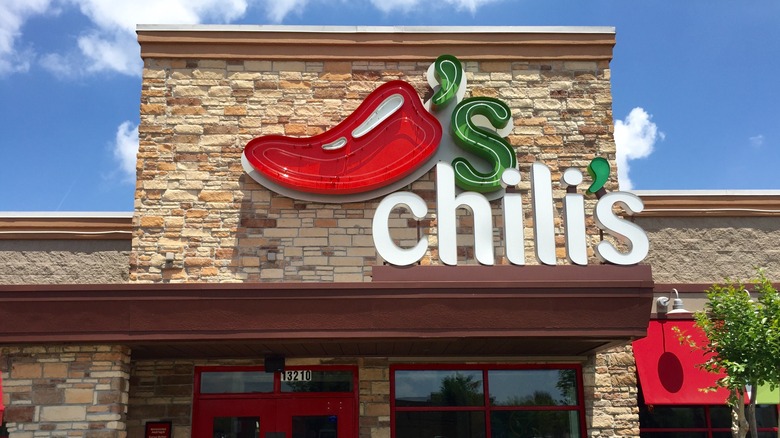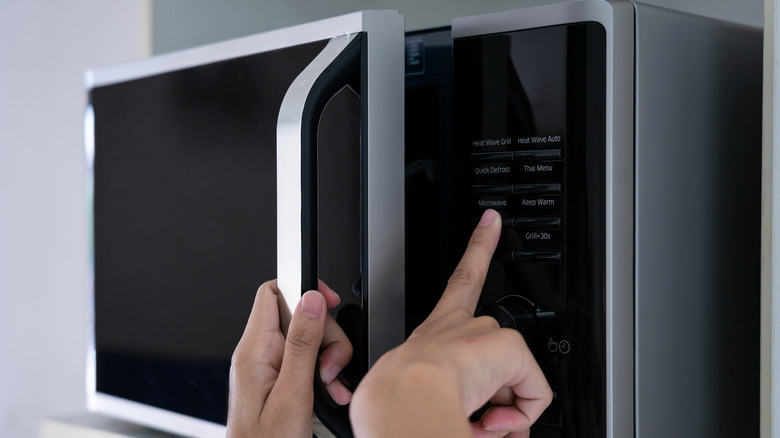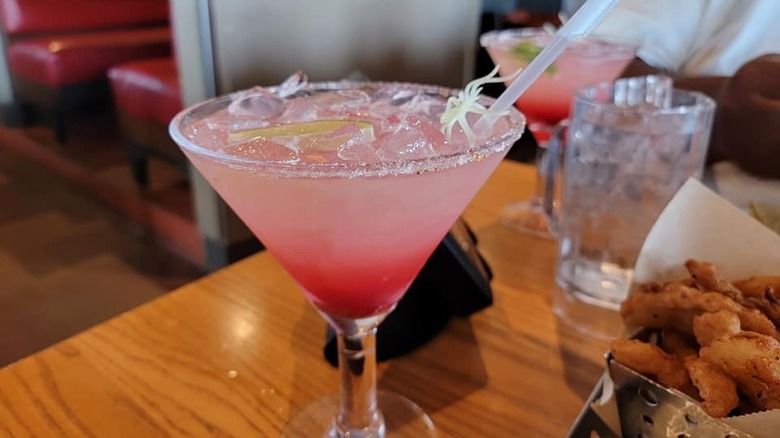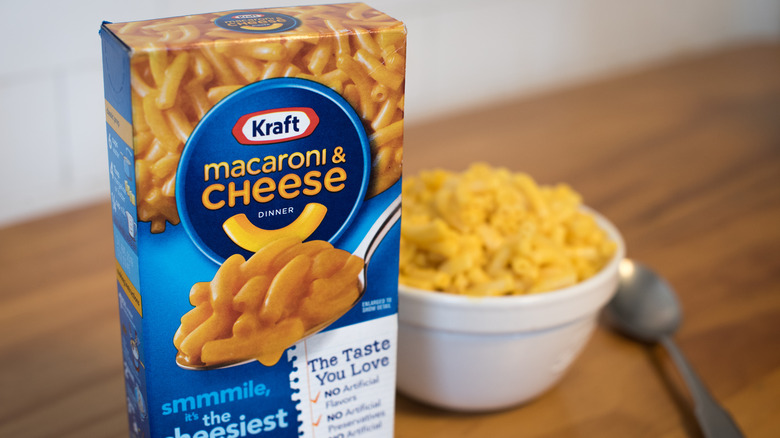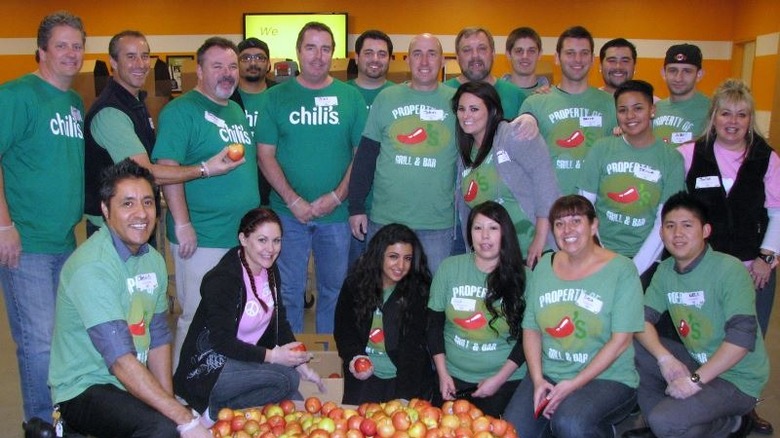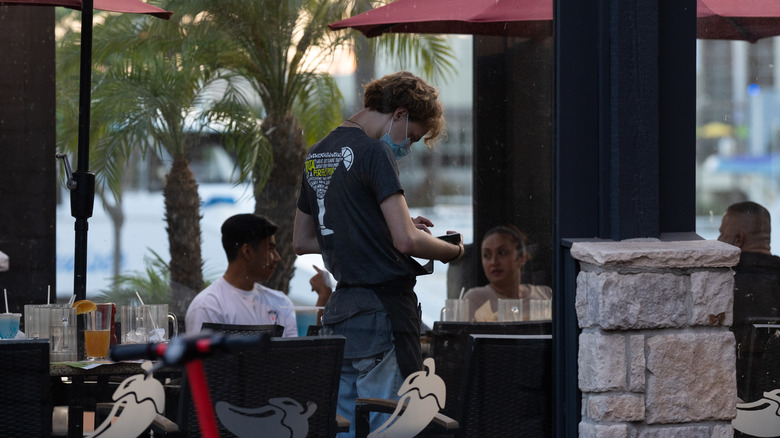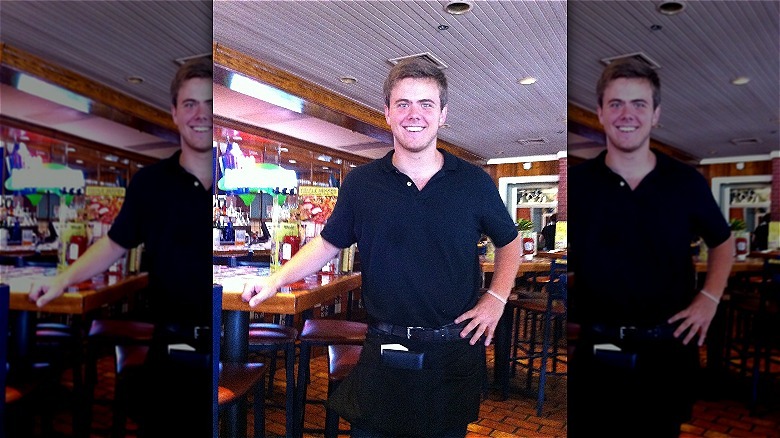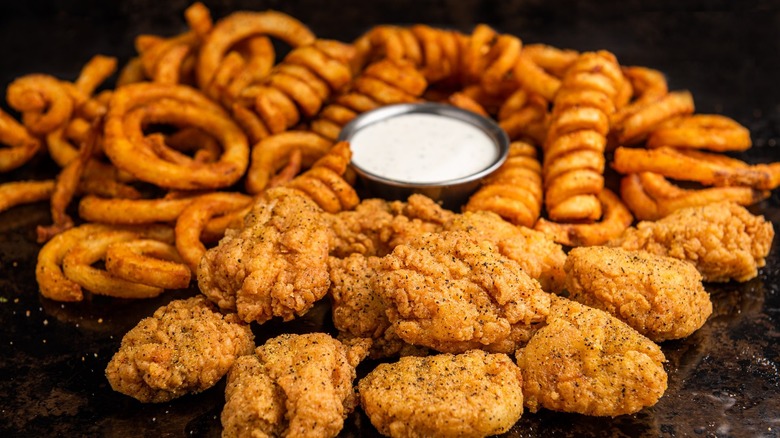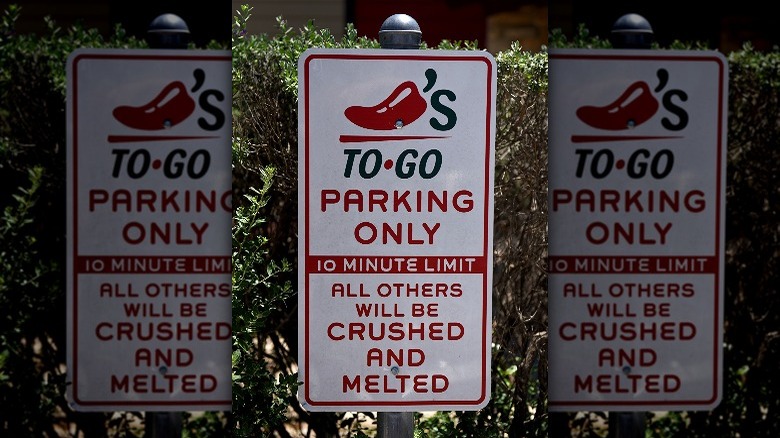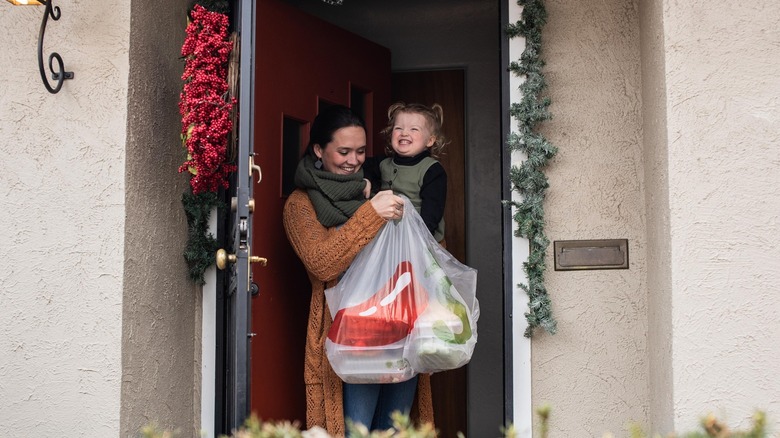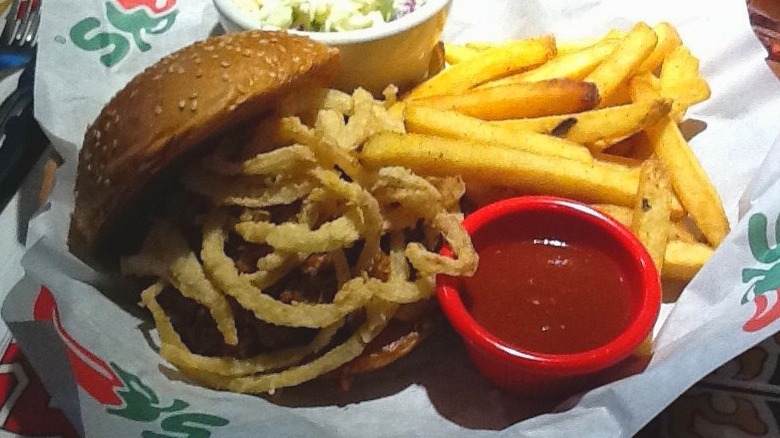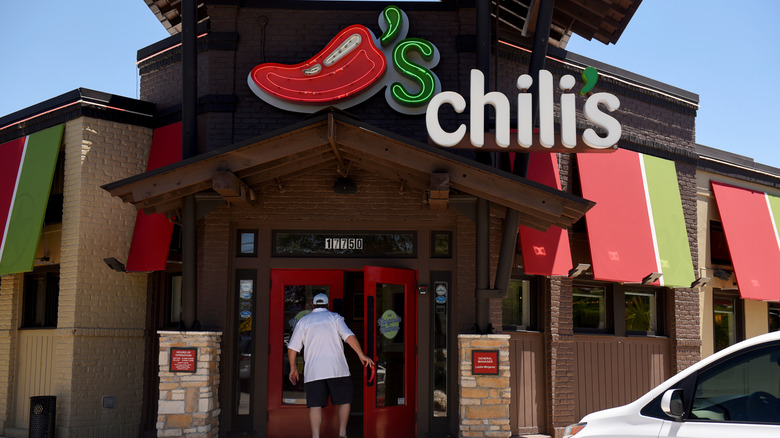We Finally Know Why Chili's Is So Cheap
No restaurant greets a grumbling stomach quite like Chili's. From sizzling platters of fajitas to large, leafy salads, the Southwestern chain truly embraces variety as the spice of life. Larry Levine opened the first location in 1975 in Dallas, Texas, according to the Dallas Observer, and it has since sprouted into the globe-trotting franchise we know it as today. Sight of that fiery red pepper glowing above the door signals good food — and good times — will be had by all who enter.
To be honest, we're a bit baffled by the Chili's business model. For how overwhelming the portion sizes can be, you never find yourself experiencing sticker shock by the time the check comes. Charging $19.99 for a juicy ribeye steak, including sides, is not a deal you'll see often at most eateries, but Chili's does it with ease. It makes us wonder how Chili's can get away with it. Can a dining establishment actually sustain itself on $5 margaritas? Or sling chicken wings and egg rolls like they're going out of style? Is there a limit to its famously bloated restaurant menu? We explored some of these burning questions about the iconic happy hour spot, and we think the answers will surprise you. Nothing too spicy, as this is a family-friendly establishment we're talking about, but enough to hopefully pique your interest (and your appetite). Wanna know why Chili's is so cheap? Read on to find out.
Most of Chili's food is frozen
Chili's menu seems to cover every cuisine imaginable. The sheer variety of flavors, from Tex-Mex to Cajun, means ordering out will never be boring. However, it also confirms the suspicion many of us believed already: Most of Chili's food is frozen. A self-proclaimed bartender and server at Chili's divulged in an Reddit AMA that "there isn't a lot of stuff not frozen," naming chicken wings and fries as the main culprits to be stashed in the icebox before hitting the fryers. Similarly, another employee came forward about the soup, which arrives frozen in bags that are thawed prior to serving.
At this point, restaurant chains relying on the freezer is as scandalous as water being wet or grass green. There are simply too many dishes on the menu to expect employees to prep batches of Southwest Chicken Soup from scratch or peel potatoes by hand constantly. Of course, it wouldn't be fair to say everything is frozen. The bountiful green salads and guacamole (which the original AMA poster confirmed were made fresh) certainly disproves that belief. Regardless, Chili's menu is undeniably huge. There has to be shortcuts for a wide array of entrees to actually be affordable, and frozen food lets Chili's accomplish that. Even if the same thing could be achieved at the freezer section of the grocery store.
Chili's uses the microwave
Is there a more genius invention than the microwave? With the push of a button, this trusty kitchen appliance can transform last night's leftovers into a deliciously hot meal. It's also used as a shortcut by restaurants to avoid preparing fresh food on the spot. For a majority of establishments, it's understandable. But that doesn't stop restaurants guilty of the practice from getting heat for it, and Chili's is no exception.
Like many restaurant chains, Chili's microwaves a lot of its food. To keep up the speedy pace demanded in any dining room, food needs to be ready at a moment's notice and served promptly. If that means reheating bread rolls so they're steaming upon arrival, so be it. It's how diners get their entrees so fast and pay so little for it. A former Chili's employee shed some light on particular menu items that typically get reheated: "The tortillas for the fajitas are all microwaved for about 20 seconds to warm before serving. The molten lava cake and cookie skillet are also warmed in microwaves" (via Reddit). Those broccoli sides? "Almost always a microwave steam bag," another employee wrote. And for those whose enchiladas are cold in the center, don't expect Chili's to dish up a fresh plate. As one alleged employee succinctly put it, "If you complain that your food isn't hot enough, it just goes into the microwave."
The margaritas come from a mix
For a cheap buzz, Chili's margaritas are hard to beat. If you were of drinking age in the 1990s, you likely contributed to the restaurant's meteoric tequila sales across the country, as well as its status at one point at the number one spot for the cocktail (per Chili's). And while a frozen 'rita won't cost $1.50 like Cheers Magazine says it used to, the drink is still a good bargain by any measure. So what's the secret? According to a Chili's employee on Reddit, the refreshing beverage is so bountiful because it's made with a mix.
As the alleged employee writes, the restaurant receives a powdered sweet and sour mix from suppliers which is stirred with triple sec, tequila, and water. This process explains why Chili's can mass-produce it in such large quantities. Compared to concocting a high-quality margarita by hand with fresh ingredients, using bulk powder is more convenient and goes a lot further in quenching diners' thirst for happy hour booze. Additionally, the cost of liquor needs to be taken into account. To put it into perspective, a 750-milliliter bottle of Patron Silver Tequila from Total Wine costs a little over $45. So for a restaurant pouring $5 margaritas, this can add up quickly. It's clear Chili's prioritizes quantity, and as long as it can continue pumping out the 135,000 gallons the restaurant claims to sell every year, it'll use whatever's the most cost-effective.
It serves Kraft Macaroni & Cheese
Families seem to be the prime demographic at Chili's, and the kids' menu is evidence of that. In addition to pint-sized pizzas and grilled cheese, Chili's serves a dish little ones probably already know by name: Kraft Macaroni & Cheese. That's right, the little blue box responsible for feeding millions since the Great Depression (per Smithsonian Magazine) is readily available at all Chili's restaurants. Even as fans of the cheesy childhood favorite, we can't help but admit this feels like a bit of a cop-out. Eating out should be an indulgence; why bother ordering something you can purchase from the supermarket and make at home?
Still, it's no mystery why this pantry staple is so popular. Kraft Macaroni & Cheese is affordable — a single box costs about a dollar at most retailers — and takes little time to prepare. All it needs is milk, butter, and that packet of bright yellow cheese powder for an immediate crowd-pleasing dinner. If Chili's knows that children will devour Kraft by the bowlful, preparing an artisanal pasta with premium cheddar would not only be a waste of time, but money. At the very least, parents with picky eaters can appreciate the gesture of familiarity.
Chili's hires a lot of employees
Chili's has over 1,200 locations in the United States (per ScrapeHero). That's a lot of restaurants to run. Naturally, it makes the case for having a lot of employees to keep things in motion. While the typical eatery employs 50 people, according to the National Restaurant Association, Chili's is an anomaly in its hiring habits. Chili's employees (also known as ChiliHeads) are hired at double the rate compared to the national average. A fact sheet provided by the chain shows at least 120 people work at any given location. Knowing over 100,000 people work for the company as a whole, according to Brinker International, these numbers appear to check out.
It seems hiring people in abundance runs counter to a chain like Chili's. Employees need to be compensated for their labor, and that labor can dictate the flow of other expenses, including pricing. But as Restaurant Business notes, maintaining a steady, trained labor pool actually reduces hiring expenses. The COVID-19 crisis has impacted the service industry in unparalleled ways, most visibly through restaurant staffing shortages. Chili's solution to this problem? Hiring more workers. In May 2021, it announced 10,000 new part-time positions had opened up around the country, with competitive wages and benefits as part of the deal (per KPRC 2 Houston). Having more hands on deck ensures costs stay low, which ensures the food on your plate is always cheap.
Employees at Chili's are paid low wages
Chili's employees work hard. Without them, the company likely wouldn't have raked in over $3 billion in profits in 2017 (per Statista). But a company's record gains aren't always felt by the people working beneath them, and this is shown by how much they're paid. Which is to say, very little. The average Chili's host makes $11.23 an hour, while servers and cooks make around $19.41 and $15.83, respectively (via Indeed). This is compounded by the fact that many employees work for gratuities, which lets Chili's get away with paying less than the standard minimum wage. Cutting labor costs makes room for customers to enjoy abundant amounts of food on the cheap; it's the only way those giant fajita platters can be justified.
Certainly, Chili's is not the only restaurant to blame for measly pittance. And change does appear to be coming, if slowly: In 2021, parent company Brinker International raised hourly wages to $17 (including tips) to maintain worker morale, according to Restaurant Dive, and plans to bump up the hourly wage as a whole to $18 by 2023. Should this come to pass, you might find yourself paying a few dollars extra for that appetizer plate. However, the trade-off is the workers who prepare it and bring it to your table will be paid more as a result. At the very least, it explains why it's so cheap to eat out at Chili's.
Retaining employees saves Chili's money
Turnover is a huge problem in the restaurant industry. Recent data from the U.S. Bureau of Labor Statics shows the resignation rate at almost 7% in 2021 alone, the highest of any industry (via Nation's Restaurant News). To retain workers for the long haul might sound expensive on the surface, but at Chili's, it's a strategy that actually saves money. FSR Magazine reported that the chain has saved $21 million by investing in processes to increase employee retention, with incentives such as wage increases, health benefits, and training programs designed for career growth (per Restaurant Dive). Additionally, it retooled its hiring practices in order to secure the best possible people for every position.
Prioritizing the needs of its workers has been a success. One example from Brinker International's Sustainability Report showed that over 2,000 employees garnered promotions under the Certified Shift Leaders Program, which trains hourly members for management roles. As Restaurant Dive explains, giving existing employees opportunities for advancement reduces the expenses otherwise spent on scoping out new talent. Retention bonuses aside, Chili's move to attract workers for the long haul isn't simply economic — it's common sense. It costs more long-term to keep replacing employees than it is to nurture the ones already under its wing, resulting in a workforce that's dependable and likely to stick around.
Virtual brands are a business booster
In today's technological landscape, virtual brands are all the rage. With everything online, you don't need to rent out a separate facility or pay overhead costs to bring your business to life. Chili's may be associated with bustling dining rooms and its legions of servers, but that hasn't stopped it from dipping its toes into the digital stream. During the pandemic's peak in 2020, Chili's launched a virtual brand of its own called It's Just Wings. The spin-off consisting of chicken wings and curly fries would operate entirely online, but Chili's locations would prep and assemble the orders for pick-up (via Restaurant Business).
Considering Chili's confidence in this venture — Restaurant Business says it predicted at least $150 million per year in profits — it's clear why virtual brands are a business booster. The menus are usually small, so fewer ingredients need to be purchased. The equipment setup is minimal, as is the packaging for takeout orders. And if it's a large chain, it can utilize the kitchens and cooking supplies already at its disposal. Opting for takeout in favor of delivery costs less, too, as no commission fees would be required as is the case for third-party apps like DoorDash. Preparing It's Just Wings orders under the Chili's roof saves money in just about every way. Plus, Brinker International's focus on virtual platforms gives them more control on pricing, which leads to the kind of reliability — and affordability — customers crave.
Chili's prioritizes takeout orders
The ultimate comfort food, in our opinion, is food you don't have to cook yourself. Upserve reports that over half of Americans order takeout on a weekly basis, with almost 60% of millennials opting for to-go service when ordering from a restaurant. For a restaurant so focused on the dine-in experience, you'd expect Chili's to kick curbside pick-up to, well, the curb. Not the case. It turns out Chili's makes a killing on takeout, to the point where it brings in a 12% chunk of its total business. In fact, Chili's success with off-premise dining factored into its largest gains made in over 10 years (via FSR Magazine).
Takeout at Chili's is nothing new. But compared to the convenience already baked into pizza shops or the drive-thru, a multi-course enchilada dinner doesn't exactly scream "quick." Brinker International CEO Wyman Roberts told FSR Magazine that providing takeout as an option offers "plenty of upside" for the brand in general. It's developed better packaging, improving the experience for customers and inspiring return business. And since Chili's already has a wide advertorial presence to begin with, the marketing costs are practically nil. Because the '"Three for $10" meals are convenient for dine-in and takeout alike, Chili's succeeded in boosting its to-go business by 20% while maintaining the brick-and-mortar service it's known for. Versatility, in other words, helps Chili's prices stay in place.
It's embraced third-party delivery
From DoorDash to Uber Eats, delivery apps are here to stay. The Wall Street Journal writes that the two companies devour 85% of America's food delivery business as a whole, which is a stunning testament to its convenience and popularity. Even so, not all restaurants have been on board. Delivery was off the table for quite some time at Chili's, mainly due to issues surrounding the transportation of its food, which the chain saw as "too high a risk" to take (per Restaurant Business). However, that all changed in 2019 when Chili's selected DoorDash as its official delivery platform.
The chain reportedly piloted multiple companies before making its decision, and they say it's a decision that's paid off. "DoorDash integrated seamlessly into our operations, demonstrated the ability to drive incremental sales, and provided a consistent Guest experience," Brinker CEO Wyman Roberts said in a statement, which cited the chain's previous success with quick-service methods like takeout that have generated $330 million per year in sales. Though delivery apps like DoorDash nab a significant percentage at the end, hosting them has its advantages. The orders are processed through Chili's existing point-of-sales system, so it doesn't spend extra on software. It doesn't have to hire delivery drivers, because contracted DoorDash employees will be tasked with dispatching the orders. Chili's doesn't even need to outsource its labor. As long as a Chili's restaurant is standing, customers can order delivery anytime.
Cutting menu items also cuts costs
One thing's for sure: It's never boring dining out at Chili's. With how many dishes it serves, you could eat there for a whole month and never have the same thing. That's not always a good thing, though. The Chili's menu has built a bloated reputation over the years, boasting 125 items at its peak (per Today). Recognizing this was a problem, Chili's decided to make some much-needed changes. In 2017, it streamlined its offerings by 40% as a way of freeing up menu space and prioritizing popular items instead. And by popular, it means the items that made Chili's a household name in the first place: ribs, fajitas, and burgers, baby.
The benefits to Chili's menu reduction are apparent. There are the logistics of serving hundreds of different entrees on a regular basis, which takes loads of time and money to do. Brand image is also a factor. As Chili's President Kelli Valade stated, "no restaurant can be everything to everyone," so establishing a consistent brand identity is important. But most of all, it results in cheaper options customers will want to flock to, because they're high-quality and affordable. Restaurant Business reports the chain experienced a 3% uptick in business following the cuts, so it's clear customers took notice of the change and liked what they saw. Focusing on fewer items — and ones that sell — means Chili's can offer the bargains we love.
Big portions at small prices keep Chili's customers loyal
Big portions of food at low prices is what Chili's does best. And at the end of the day, it's what keeps customers coming back. It's true that promotions are the key to driving profits, but Chili's strength lies in offering those low costs from the beginning. In a report from FSR Magazine, Wyman Roberts cites the "value proposition" of the Chili's menu, which emphasizes reasonable price points in favor of fleeting, limited-time discounts. Doing so accomplishes a few things. On Chili's behalf, it reduces marketing expenses. But for customers, it plays on something a tad more psychological. Since the prices are good all year round, diners craving the full spread won't have to wait for a coupon code to eat out at Chili's. They can go wherever and whenever, which encourages repeat visits.
Many examples of this phenomenon abound in Chili's mammoth-sized menu. Take the "3 for $10 special": Each meal features an entree, appetizer, and drink. Similarly, the "Meal for 2" menu special comes with an appetizer, two entrees, and a dessert for only $25 (per Chili's). Both deals live up to the promises they make of cheap, plentiful food that can be customized according to taste. In turn, this draws the consistent business Chili's depends on to remain so cheap. It's an illusion, but an illusion that works time and time again.
